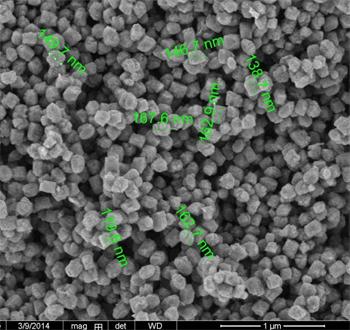Al-MCM-41 Molecular Sieve |
|||||||||||
 |
|||||||||||
Item : |
|||||||||||
Details :MCM-41 belongs to one dimension pore structure. It has uniform aperture, and high specific surface area (800-1000 m2/ g), and good adsorption capacity (0.7ml/g), and is more suitable for organic molecule speedy diffuse than zeolite and phosphate & aluminates etc. As a result, it is able to macromolecule, especially heavy oil organic molecule in petrochemical process enough room and effective acidity to proceed. And it could also adjust aperture and acidity consistency & intensity, indicating that it has strong latent value in separation processes of residuum catalytic cracking, heavy oil hydrogenated, fluid oil hydrogenated, alkylation, olefinic polymerization, isolation of CO2-CH4.
Technical Parameter
--------------------------------------------------------------------------------------------------------------------------------------------------------- Sheng Wu Gong Cheng Xue Bao. 2011 Mar;27(3):398-403. [Influence of ZSM-5(38)/Al-MCM-41 composite molecular sieve catalysts on pyrolysis of cellulose].[Article in Chinese]
AbstractPyrolysis of cellulose with different catalysts has been conducted in a fixed-bed reactor. Micro-mesoporous composite molecular sieves of ZSM-5(38)/A1-MCM-41 with different Si/A1 ratios were prepared under hydrothermal conditions. With powder X-ray diffraction (XRD), the catalyst samples were characterized. GC-MS was used to analyze the bio-oil composition. The effects of catalysts on the pyrolysis product yields were investigated and the results were compared with the results of experiments performed without catalyst under the same pyrolitic conditions. The presence of the catalysts decreased the liquid yield, while increased the moisture content. The major improvement in the quality of bio-oil with the use of catalysts was the increase of DL-2,3-Butanediol. ZSM-5(38)/A1-MCM-41(20) favored the formation of phenol and 2-methoxy-phenol. In addition, these catalysts were all benefit for the generation of small molecular compounds. Also, it was found that ZSM-5(38) was better for the production of C4-C5 compounds. And micro-mesoporous composite molecular sieves mainly promoted the production of C6-C8 compounds.
|
|||||||||||
| [NextUSY0.2] [Previous] | |||||||||||
|

